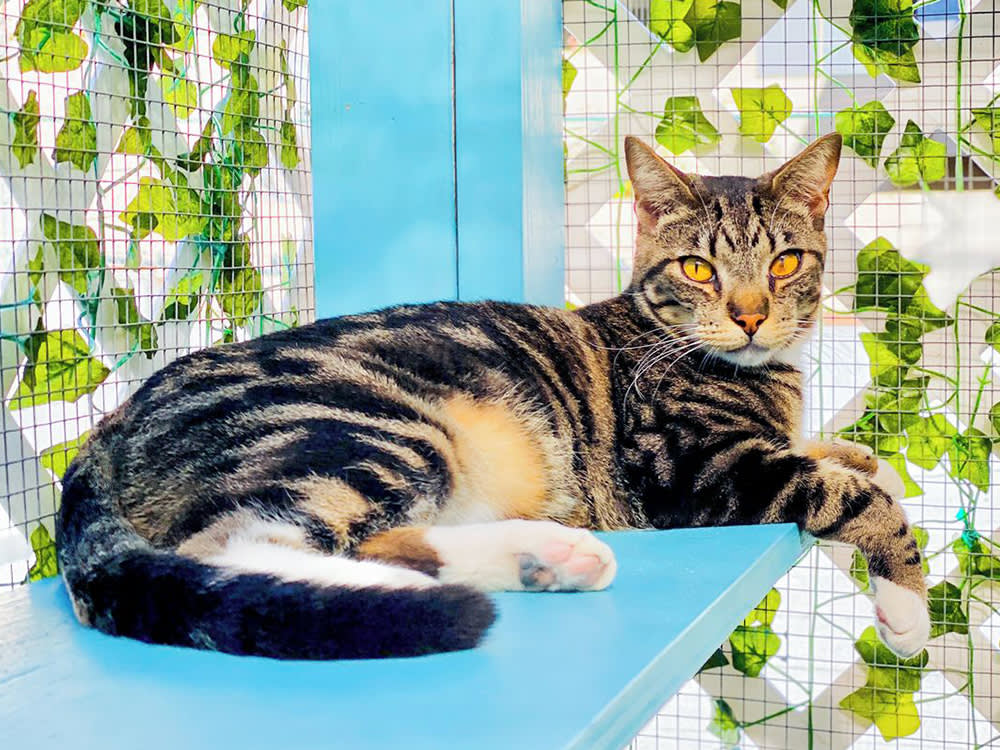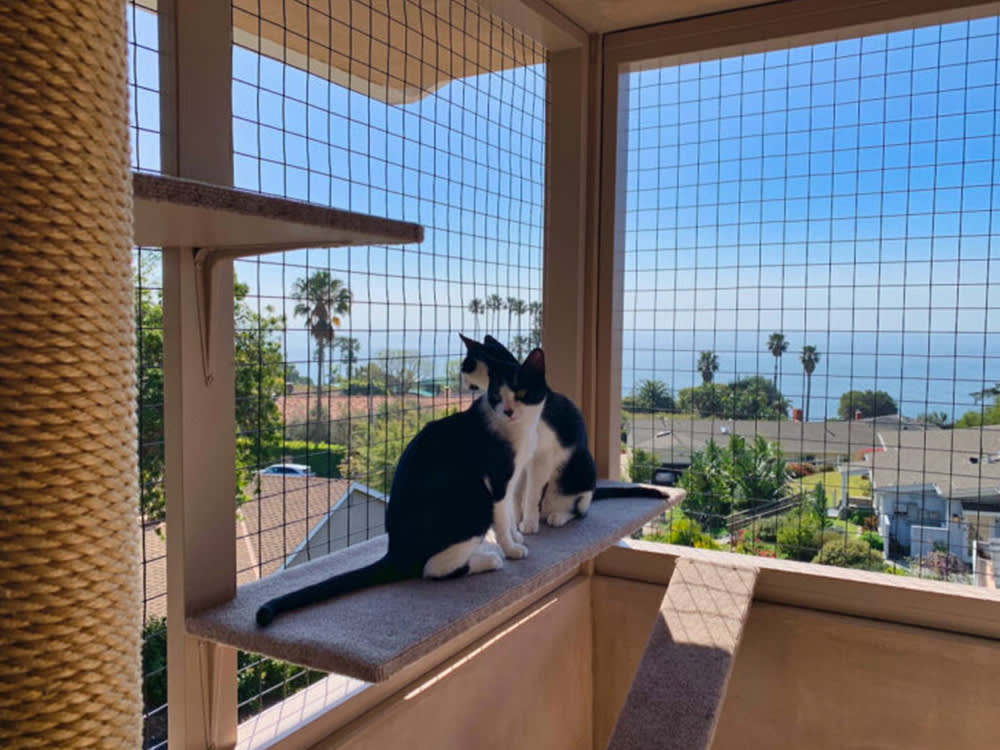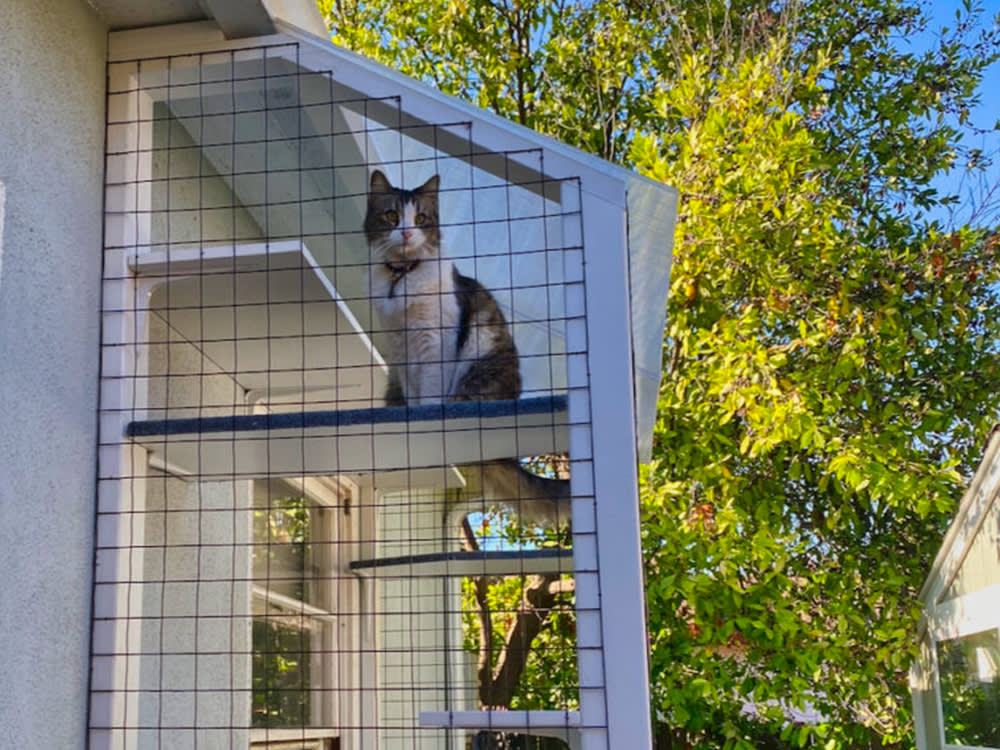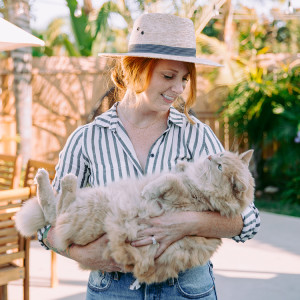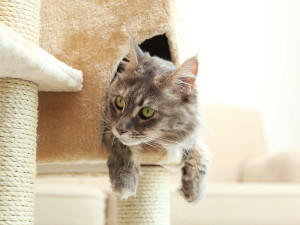How to DIY a Catio
Cat behaviorist Cristin Tamburo’s tips for building a safe outdoor space for your cat.
Cats yearn for the outdoors. Even the most pampered indoor kitty sits on a window ledge and stares at the world going by, their curiosity piqued by every passing leaf and bird. But that curiosity has to be tempered with safety — like what’s provided by the fenced-in outdoor space of a catio.
A catio (cat + patio) is an enclosed outdoors space, usually attached to a window or a cat flap, that lets your pet get fresh air and all the smells and sights of the outdoors, but without them wandering off and getting into fights with the local raccoon population. And while high end designer catiosopens in new tab are a thing, you can also build one yourself with some basic construction knowledge and a bit of time on your hands.
Save on the litter with color-changing tech that helps you better care for your cat.
Cat behaviorist Cristin Tamburoopens in new tab told us that a catio is all about giving your cat more stimulation, which can make them happier and even help with some behavioral issues. “A more mentally and physically active and stimulated cat is one less likely to have behavioral issues,” as she put it. She’s a big proponent of exposing your cat to the outdoors as long as it’s “safe, secure, and supervised” — and a catio provides just that, letting your kitty get the wind in their whiskers without you worrying about predators, cars, or other hazards. If you do want to take the plunge into the world of building an outdoor cat playpen, here are some tips to keep in mind while you tackle what could be a day-long build or a week-long project, depending on your schedule.
Location, Location, Location
The first decision rests on size and shape. How big do you want this thing to be and where is it going to go? It could be as simple and small as a basic box that attaches to your window, giving your cat a place to perch. Or it could be a mammoth playpen, connected via tunnels and hallways. If you’re short on square footage, remember that you can also build a tower, as cats love to climb. Tamburo suggests building a catio that is large enough to allow all of your cats space to play, so that there’s no conflict about which pet gets to smell the great outdoors. If you have a single cat, a window box might be fine, but for more, scale up the size.
Alan Breslauer of Custom Catiosopens in new tab emphasized was the importance of location. During our conversation, he told me to prioritize a spot with fresh air, sunshine, shade, and “as much green as you can find…the goal is to get your cat as much stimulation as possible.” You can always bring non-toxic plants nearer the catio for a better environment, if there’s nothing growing nearby.
Catio Designs
Once you’ve decided on what type of catio you want, you can hunt down free plans online or buy them through services like Catio Spacesopens in new tab. If building a catio from scratch seems a bit more than you’ve bargained for, you can buy kits from sellers like Habitat Havensopens in new tab. Though they may be less of a bargain, as even a basic window box starts at more than $300.opens in new tab Getting existing plans for free isn’t too hard — you can find them from reputable outlets like This Old Houseopens in new tab. I’m particularly partial to this IKEA hack from Cutenessopens in new tab that turns a pair of cheap shelves into a rather nice basic catio (though, you might want to finish the wood firstopens in new tab so that it lasts longer).
If you’re designing the catio yourself, the fundamentals are fairly straightforward (a wooden frame enclosed in a wire fence), but there are a few details you’ll want to sort out in advance. Even the most basic catio needs an external entry point for humans so that you can easily access your cat in the case of an emergency, or more prosaically get in to clean it. Also consider weatherproofing — even if your cat won’t want to play in it when it’s raining and miserable, you’ll still want to keep it dry. You can even simplify it further if you want, Tamburo told us that she built her catio using PVC piping and zip ties, which would work if you don’t want the hassle of wood and staples.
Safety Measures
The catio needs to be enclosed on all sides — including the bottom, or else your cat is going to dig out, or something else is going to dig in. You can put down a concrete pad if you want long-term stability, but paving stones would also work. If you’re not planning for a hard bottom, attach fencing across the entire base of the construction for extra security. As Breslauer explained, “cats probably prefer the natural feel of grass or dirt, but an artificial base is easier to clean, and tracks in less dirt. And cats don’t spend that much time on the ground anyway.”
Decide how your cat will get in and out of the catio. The most straightforward option is just to have the frame against a window, but your cat then relies on you for access to their favorite outdoor spot — which will inevitably lead to 5 a.m. yowling when they want to see what the early birds are doing. If you’re not able to cut a dedicated cat flap into the wall as a permanent exit, Breslauer recommends using an in-window cat flapopens in new tab, which slots into your window frame and lets your pet come and go as they please.
Construction Time
Once you have your plans, time to get together your supplies. For wood, use something that will handle sun and weather well — cedar is a classic, and redwood is lovely if you have access to it. If you choose an unfinished wood, be sure to finish it with a pet-safe productopens in new tab so it lasts as long as possible.
For your fencing, you’ll want something that’s hardy enough to withstand an excited cat trying to get out, and to prevent outside critters from sneaking in. Breslauer suggests 1x1-inch or 2x2-inch fencing, as chicken wire may not hold out an excited raccoon (or worse, coyote). If you live somewhere where flies or mosquitos are a problem, consider doubling up your fencing with patio screens. This Old House’s plans for a catioopens in new tab use just the latter, but given what my cat can do with her claws, I don’t think that would hold up as the sole means of enclosure. Even with the existence of pet-proof screeningopens in new tab, the extra thickness and security of proper fencing makes the most sense.
When you’re building your catio, be careful to staple the wiring into the frame well, without gaps where an excited cat could push their way out. Breslauer highly suggests buying or renting a staple gun, since it’s arduous to do by hand. And since you’ll probably be cutting the fencing to size with tin snips, be sure to file down the cut edges so there’s nowhere that could snag on your pet’s coat. As you attach the catio to the side of your house, keep your eye out for external pipes and wiring that might get in the way, and try and ensure that there are no gaps where the window or cat flap connects to your construction.
Finishing Touches
Once your catio is built, make it something that your cat wants to explore. Horizontal platforms for lazing on are a must, and if you can fit in a scratcher, it’ll make it even more enticing for your pet. Try putting some of your cat’s favorite toys into the catio to entice them in, as well as a comfortable bed — and give your pet plenty of time to explore. If your cat has previously been indoors only, this might be a good time to get them on prophylactic flea medicine, as no matter how fine a mesh is on the catio, fleas can still get in. And even though it’s outdoors, as with any cat living space, be sure to keep it clean.
With a bit of planning, and some good materials, you can fairly easily build a catio that will last for years, and for substantially less than buying a kit off Amazon. And the elation of assembling something with your own two hands for your floofy friend is too satisfying an opportunity to pass up.
